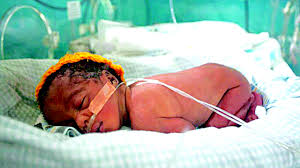Aisha Abdullah, a registered midwife in Gombe State, had just begun her morning shift at a local primary healthcare center when an urgent call interrupted her routine. A pregnant woman had arrived in active labour. While the team prepared for the delivery, Aisha asked a few quick questions and made a troubling discovery. The expectant mother had not attended a single antenatal care session throughout her pregnancy.
This raised immediate concerns. Moments later, the baby was born prematurely, estimated to be just between twenty eight and thirty weeks old. The mother had unknowingly suffered from polyhydramnios, a condition where too much amniotic fluid builds up in the womb, often making the abdomen appear larger than normal and increasing the risk of early labour.
This case is not uncommon in Nigeria. According to the International Journal of Gynecology and Obstetrics, Nigeria ranks third globally for preterm births, with over seven hundred and seventy four thousand cases recorded annually. A large number of these cases occur among women who do not attend antenatal care sessions.
Preterm birth is a leading cause of neonatal deaths in Nigeria. The World Health Organization advises that pregnant women attend at least eight antenatal visits during pregnancy to ensure better health outcomes for both mother and baby. Yet, a twenty twenty four study by the National Library of Medicine reveals that only about twenty percent of Nigerian women meet this guideline.
Strengthening antenatal care education and access is vital to protecting the lives of mothers and newborns across the country.
Nearly eighty percent of women in Nigeria miss crucial chances to detect and manage high-risk pregnancies. In rural areas, challenges like lack of transport, deep-rooted cultural beliefs, and limited understanding of the value of antenatal care continue to stand in the way.
According to Aisha Abdullah, a registered midwife, many of the complications that result in premature births could be avoided with consistent access to antenatal care. She explained that even when the services are offered for free, some women still stay away due to lack of awareness or family support.
Primary healthcare centres, known as PHCs, are intended to be the first line of care for mothers and newborns. However, in many rural areas, these centres are struggling. A lack of funding, poor infrastructure, and limited staffing mean they are often unable to properly handle preterm birth emergencies.
An example is the Numba Koro PHC in Niger State. This facility, classified as level one, is meant to provide antenatal care, childbirth services, and immunisation. But during a visit by Nigeria Health Watch, it was clear the building had fallen into disrepair. The toilets were blocked, the roof leaked, and the shelves were nearly bare of essential medicines. Only two contract staff were present to serve the entire community.
Pregnant women in the area often have to walk more than five kilometres to get medical attention. For those with high-risk pregnancies, such delays can be fatal. Aisha stressed the urgency by saying that when a woman is at risk of delivering prematurely, immediate referral is vital.
Improving antenatal education, strengthening PHCs, and removing barriers to access are key steps in reducing preterm births and saving lives across Nigeria.
Even though national programmes like Group Antenatal Care aim to improve access to health education and peer support for pregnant women, they struggle to thrive in rural communities. Many primary healthcare centres lack the space, trained staff, and essential infrastructure needed to run group sessions effectively.
Nigeria’s Policy Commitment to Maternal and Newborn Health
To tackle maternal and newborn deaths, Nigeria has introduced several national policies that focus on strengthening healthcare delivery.
One of these is the Nigeria Health Sector Renewal Investment Initiative, launched in December twenty twenty-three. It seeks to improve maternal and under-five health through investment in primary healthcare, infrastructure, and workforce training.
Another is the Maternal and Newborn Mortality Reduction Innovation Initiative, launched in November twenty twenty-four. This policy targets high-risk communities and aims to reduce delays in seeking and receiving care. It supports emergency obstetric and newborn care, expands access to health insurance, and promotes the training and retention of health workers. Through collaborations with local stakeholders, it works to reduce maternal and newborn deaths, especially among preterm infants.
Gaps Between Policy and Practice
Despite these strong national policies, several key issues continue to fuel the crisis of preterm births in Nigeria:
Weak Implementation at State and Local Levels: Many states lack the capacity or political will to effectively carry out national programmes. As a result, even the most well-planned initiatives struggle to make a real difference on the ground.
Insufficient Funding for Specific Needs: While health budgets have increased overall, there is still a lack of dedicated funding for proven interventions such as Kangaroo Mother Care or basic neonatal equipment like breathing machines. Without these, many facilities are unable to manage premature births effectively.
Shortage of Skilled Health Workers: Many trained healthcare professionals leave the country in search of better opportunities. Those who remain are often overwhelmed and unevenly distributed, especially in rural areas. Preterm babies need specialised care, and without trained personnel, survival chances drop significantly.
Poor Data Collection and Usage: Data is essential to drive progress, but Nigeria continues to struggle with weak systems for tracking maternal and newborn health. This makes it difficult to target interventions and measure impact.
From Policies to Action
Solving the challenge of preterm births in Nigeria will take more than good policies. It requires practical action across all levels of government and society. This includes:
Dedicated funding for newborn care
Performance-based financing that rewards results
Stronger systems for monitoring and accountability
By focusing on these priorities, Nigeria can turn its policy goals into real progress — saving the lives of mothers and their newborns, especially the most vulnerable preterm infants.
In addition, Nigeria must prioritise the standardisation and full implementation of evidence-based clinical protocols across all levels of healthcare. This includes ensuring that healthcare providers follow best practices during antenatal, delivery, and postnatal care. Regular case reviews and mortality audits should become routine, allowing healthcare teams to learn from past experiences and make improvements that directly impact maternal and newborn outcomes.
Another critical step is boosting the local production of life-saving medical supplies such as antenatal corticosteroids and magnesium sulphate. These medications have been scientifically proven to reduce the risk of preterm births and their complications, yet they are often unavailable in health facilities where they are needed most.
When these strategies are integrated into existing health policies, Nigeria can move from a system that reacts to complications to one that actively prevents them. A proactive approach to maternal and newborn health can significantly improve survival rates, particularly for babies born too soon. It will also build a stronger, more resilient, and more equitable healthcare system that protects not just mothers, but the future generation from preventable loss.




No comment